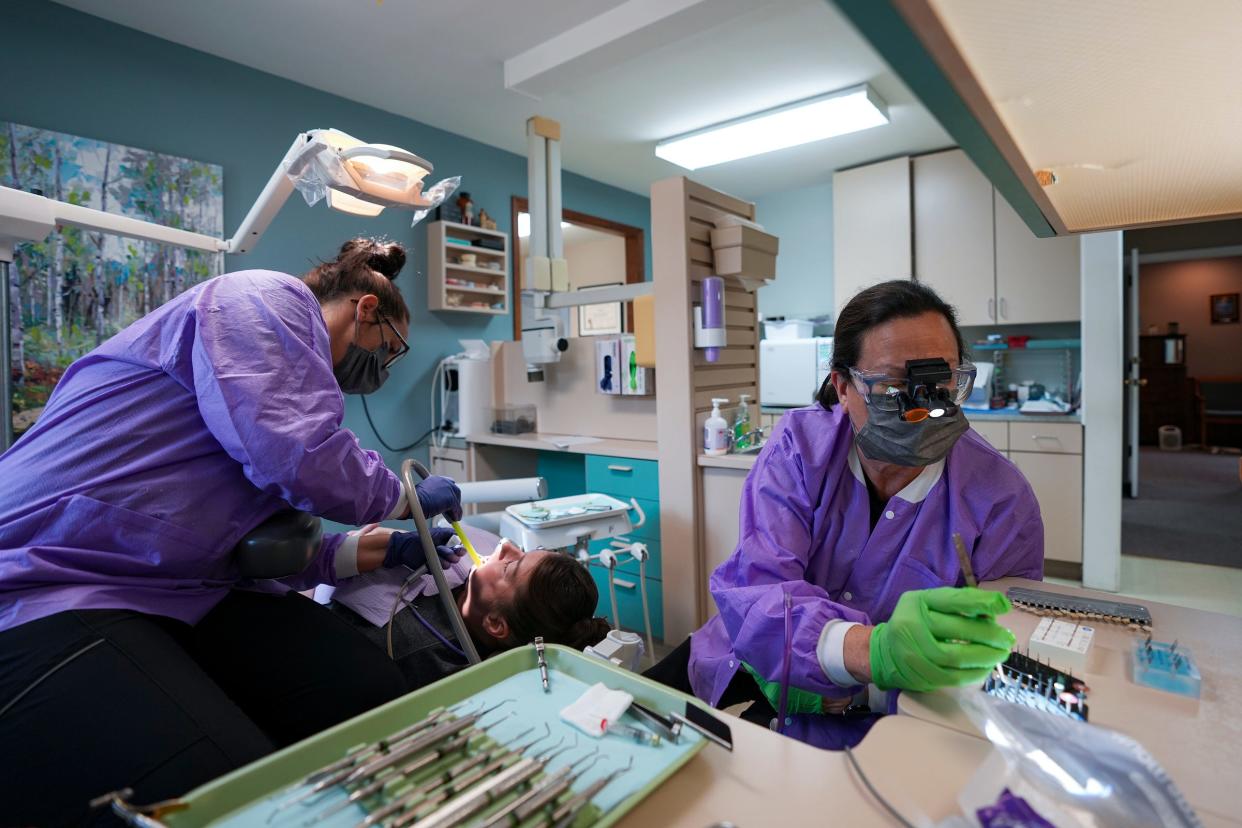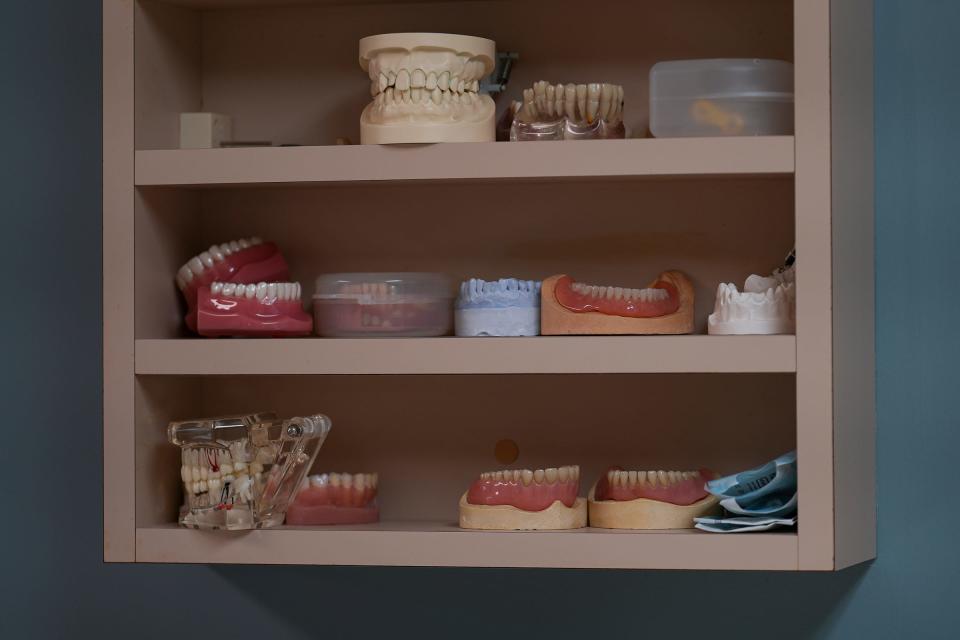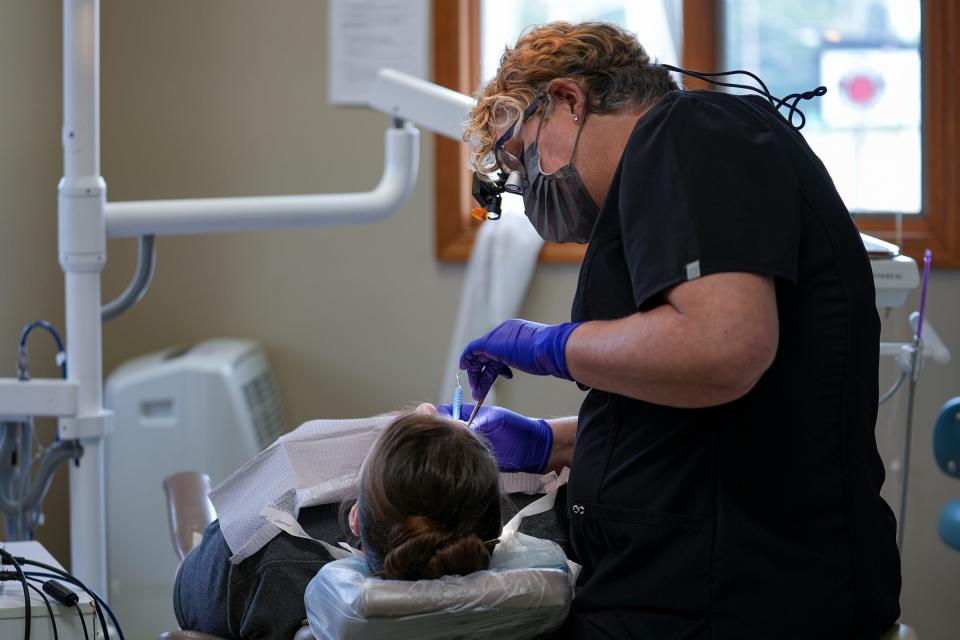Going from a problem to crisis: Dentist shortage hits Medicaid patients hardest

When Jessica Brock started looking for a new dentist for her teenage son, she made phone call after phone call to find someone in the Richmond area who would take Medicaid.
The Hagerstown resident contacted more than 10 dental offices, some as far away as Muncie, only to be told by all they no longer accepted Medicaid patients. She never would have imagined it would be so difficult to replace her retiring dentist. But she needed to find one because her 17-year-old son was facing a root canal and she hadn't had a teeth cleaning since the pandemic started.
“Great," Brock thought to herself, "what am I going to do?”
Finally she reached Dr. Jill Burns, who said she would take on both Brock’s son and Brock as new patients.
Brock's experience is all too common among patients paying with Medicaid. As the state faces a dental shortage in many areas, people on Medicaid, which typically reimburses at only a fraction of what commercial insurance pays, are finding it harder to locate a dentist. And once they find one, the waits often are long.
Others are reading: Westfield investigating Harry Potter-themed school for 'at-risk' children
Many in the dental profession fear that problem will only increase, especially in rural and inner-city areas, some of which already have shortages of dentists.
The Indiana Dental Association and many dentists had hoped that the most recent legislative session would end with a pronounced increase in Medicaid rates, something that has not happened for years. Lawmakers in fact did bump up dental care by 10% earlier this year, but even that isn't enough to address the situation, said Doug Bush, executive director of the Indiana Dental Association.
“My concern is that there's going to be a significant increase in the number of doctors who quit providing care under the program,” he said. “We knew that it was a problem, especially in some areas and with the specialists. I think it's going to go from a problem to a crisis now.”
Dental health shortage areas in Indiana
According to a 2022 Indiana University report, 52 of Indiana's 92 counties are designated as dental health professional shortage areas. Crawford, Warren and Union have no dentist practicing at all and Union has no dental hygienists as well. Several counties have fewer than five dentists or dental hygienists, according to the report from IU’s Bowen Center for Health Workforce Research & Policy.
None of the counties in the Indianapolis metro area falls into this category, according to the report.
The situation will likely intensify as Indiana is projected to need more dentists in the coming years, due in part to older dentists retiring. The Indiana Department of Workforce Development forecasts a 20% increased demand for dentists in the coming decade, compared with 6% on national basis.
The 2022 Bowen Center report found that about 40% of the dentists surveyed say they treat Medicaid patients and just under 35% of dentists in the state who responded said they accept new Medicaid patients.
Others are reading: County officials may review HEPL appointees' performances, skeptical on firing director
However, it can be hard to get a handle on just how many dentists accept Medicaid and whether that number has decreased substantially in recent years. And of course, it’s impossible to predict how many additional dentists may leave the program in the future.
Data from the Indiana Oral Health Coalition, an independent agency that partners with the state to promote oral health, suggests that the number of treating dentists who take Medicaid did not decline significantly from 2019 to 2022, Coalition Chair Dr. Leila Alter said. These numbers, however, include anyone who filed any claim with Medicaid so if a dentist has decided only to stop taking new patients, he or she will still be included in this tally.

No incentive to become Medicaid providers
IDA president Dr. Tom Blake heard before the session promises that dentists would see a significant increase. Instead, he said, the upshot of the session was that some reimbursement rates will increase while others will decrease. Fed up, he decided to leave the Medicaid program after 42 years.
“I just can’t continue,” he said, noting that doctors see a cost of living increase from Medicaid every year. “At some stage you just have to draw the line…. I don’t know of any profession where we don’t get a raise for 25 years.”
The Fort Wayne dentist said he will keep treating his special needs patients who have Medicaid on a pro bono basis.
Out of more than 325 dentists in his immediate area, Blake said he knows of only two who will take Medicaid and he’s referring his patients to them.
Over the past year Dr. John Roberts, a general dentist in Connersville, has also stopped taking most Medicaid patients though he will still treat current patients, those having dental emergencies and children.
Years ago, he said, no more than 20% of his patients were on Medicaid. That number crept up to nearly 40% by 2016. Now, with a number of jobs lost in the area, that percentage has crept closer to 60%.
“Frankly I could live off of what I don’t get paid,” Roberts said. “I’m writing off almost $10,000 a month. That’s a lot of money.”
OPINION: We have a shortage of health care workers in Indiana. Here's how to solve it.
Dentures, for instance, in many cases wind up costing more for the dentist to make than he or she receives in Medicaid reimbursements.
Only about half of the young dentists entering the field today start their own practices, compared with about 80% a generation ago, said Dr. Harvey Weingarten, associate dean for clinical affairs and an assistant professor in comprehensive biomedical sciences at Indiana University School of Dentistry. Much of the remainder of dental graduates find employment with large corporate or group practices that often do not take Medicaid.
In a similar vein, those in private practice may feel little inclination to serve lower-income patients with state insurance, Weingarten said.
“There’s no incentive for them to become Medicaid providers, short of the good will that they’re giving away,” he said. “They’re losing money on every patient that walks in the door.”

Some call leaving Medicaid 'rash decision'
Not every dentist, however, has thrown up their hands in despair at the Medicaid reimbursement situation.
Indiana Health Coalition Chair Alter said she thinks her colleagues should wait to see how the 10% increase plays out before making a final decision on whether to continue taking Medicaid patients.
The Family and Social Services Administration, which oversees the Medicaid program, has been holding meetings with dentists to decide how to implement the increase and has been discussing which services should see a bump in reimbursement and which should see the rate lowered.
While dentists may now see a decrease in payment for some services, they will also see substantial increases in payment for other services, Alter said, adding that the state hopes to finalize the fee schedule in September. She said she fears many of her colleagues right now are making “rash decisions” to leave Medicaid based on rumors.
“It’s going to come out better than what people anticipate,” said Alter, who has a limited patient schedule in her Bedford practice due in part to staff shortages that have persisted since the pandemic. “It’s not going to be the worst case scenario, what everybody has been expecting.”
But many dentists are not happy with having to prioritize which services should see an increase, the IDA’s Bush said.
Should prevention be valued over restorative treatment or vice versa? Yes, prevention can save money in the long run but those who have already run into dental problems and lack teeth may find it difficult to find employment or they may have poor nutrition because they can only eat soft foods, he said. Others may develop medical problems because of their poor dental hygiene.
“It is a internal discussion we're having on what to do with the few dollars that have been made available to try to make things better and it really puts our membership in a tough spot,” Bush said. “It’s essentially having to rob Peter to pay Paul in some of these instances.”
Further complicating matters, this year due to changes in federal requirements, the state will equalize reimbursement rates between traditional Medicaid and the state’s Healthy Indiana Plan, which until now has reimbursed at a significantly higher rate.
When asked specific questions about the situation with dental reimbursement, FSSA Director of the Office of Strategic Communications and Public Affairs Michele Holtcomp referred the IndyStar to FSSA Secretary Daniel Rusyniak’s comments during a July video update about changes in Medicaid.

Medicaid rates for physicians in the state will soon equal those of Medicare —a substantial increase — but that was not an option for dentists as the federal Medicare program does not cover oral health. Without the 10% budget increase to equalize HIP and traditional Medicaid, the future HIP reimbursement rates would have dropped to 89.5% of current rates. The increase means HIP patients will be reimbursed at 98.4% of current rates, Rusyniak noted during the two minutes of the 45-minute-plus call that he discussed dentistry.
This development does not mollify the IDA’s Bush, who had hoped to see an increase in rates across the board, rather than a decrease — albeit a small one — in some areas. In the eight years since the HIP program began, dental rates have never been adjusted for inflation, he said, and for many procedures HIP reimbursement already does not cover the full cost of providing care.
“The state seems to have in place the ideal program to discourage dentists from wanting to be Medicaid providers,” Bush said.
‘All about politics and money’
Nor is it only money that can drive dentists out of Medicaid. Dr. Stephen Towns has worked as a periodontist for nearly five decades at his Sonrisa Dental office in downtown Indianapolis and always accepted Medicaid.
Six months ago he decided he had had enough.
Time after time, he would file a claim for periodontal care with a Medicaid insurer, only to be flat-out denied. Without the treatment he would have provided, he said, these patients would likely lose their teeth.
Not only did he become frustrated with the payers, he also found dealing with some Medicaid patients trying, he said. Because they may have uncertain transportation, child care, or irregular work hours, more often than not patients on Medicaid would make appointments and fail to show.
At this point, he said, he knows of no periodontists in the city or even the state who accepts Medicaid.
“It’s all about politics and money,” he said. “I think this was something that if it affected the majority population, there would be something done about it.”
Even dentists who have stuck with the Medicaid program say that it’s not an easy choice to make. Burns, a dentist with West Main Family Dental in Richmond, said she knows of no other dentists among the approximately 30 in the immediate area who still take Medicaid patients. Burns, however, said she has no plans to stop, although the finances can be challenging.
"It’s easier to give it away for free, which I do on occasion do,” she said. “These folks need to be taken care of, somebody’s got to do it.”
Contact IndyStar reporter Shari Rudavsky at shari.rudavsky@indystar.com.
This article originally appeared on Indianapolis Star: Dentist shortage hits Medicaid patients amid lagging state funding

